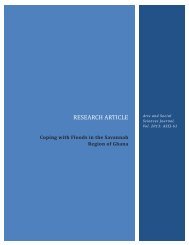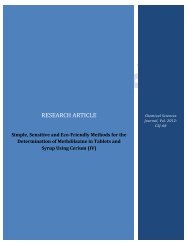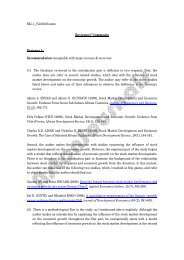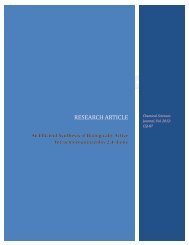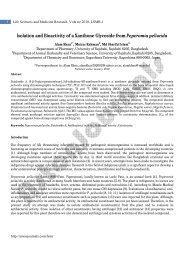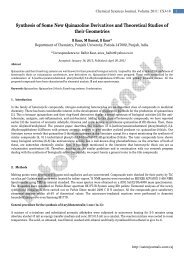Polyester Polyol Derived From Waste Poly - AstonJournals
Polyester Polyol Derived From Waste Poly - AstonJournals
Polyester Polyol Derived From Waste Poly - AstonJournals
You also want an ePaper? Increase the reach of your titles
YUMPU automatically turns print PDFs into web optimized ePapers that Google loves.
RESEARCH ARTICLE<strong><strong>Poly</strong>ester</strong> <strong><strong>Poly</strong>ol</strong> <strong>Derived</strong> <strong>From</strong><strong>Waste</strong> <strong>Poly</strong> (EthyleneTerephthalate) for CoatingApplication on Mild SteelChemical SciencesJournal, Vol. 2012:CSJ-76
Chemical Sciences Journal, Vol. 2012: CSJ-761<strong><strong>Poly</strong>ester</strong> <strong><strong>Poly</strong>ol</strong> <strong>Derived</strong> <strong>From</strong> <strong>Waste</strong> <strong>Poly</strong> (Ethylene Terephthalate)for Coating Application on Mild SteelJ Purohit, G Chawada, B Choubisa, M Patel, B Dholakiya*Department of Applied Chemistry, SV National Institute of Technology, Surat, Gujarat, India.*Correspondence to: Bharat Dholakiya, bharat281173@gmail.comAccepted: Oct 12, 2012; Published: Dec 14, 2012AbstractUseful coating products may be obtained by chemical valorization (glycolysis) of post consumed poly (ethyleneterephthalate) (PET) wastes. Glycolysis of PET waste was carried out using poly (propylene glycol) (PPG) of molecularweight 2000. The depolymerized oligoesters obtained were trans-esterified with Castor oil and Jatropha oil which results inthe formation of saturated hydroxyl-functional polyester polyols. Two-pack coating systems were formulated using theseresins as base component and melamine formaldehyde resins as hardener component. Cured films were tested for theirhardness, chemical and corrosion resistance performances. The glycolysis of PET using PPG and polyester polyol formationwas characterized using Fourier transform infrared spectroscopy.Keywords: PET waste; Castor oil; Jatropha oil; corrosion resistance.1. Introduction<strong>Poly</strong>ethylene terephthalate (PET) is aromatic polyester with excellent thermal and mechanical resistance andoutstanding chemical properties, which is used especially in the manufacturing of fibers, packing materials,and plastic bottles. Widespread application and non-biodegradability of PET creates huge amounts of wasteand, consequently, induces a great interest for recycling this material. Therefore, a key issue nowadays is thePET conversion into reusable products [1]. With increasing application and decreasing prices, PET became thesymbol of disposability in consumerism and hence a noxious material of concern in relatively recentenvironmental protection issue, as it is highly resistance to atmosphere and biological agent. Therefore, thenecessity of finding a simple economic route for the recycling of waste PET is an important practice forsustainable recycling and contributes to the conservation of raw petrochemical products [2-5]. PET recycling isalso important for conservation of oil resources, reduction of greenhouse effect, and energy preservation [6].PET is thermoplastic polyester that is formed by a reaction between terephthalic acid and ethylene glycol [7].Hence, its solvolytic chain cleavage is possible using various reagents like water (hydrolysis) [8–11], alcohols(alcoholysis) [12, 13], acids (acidolysis), glycols (glycolysis) [14] and saponification [15, 16]. During solvolyticchain cleavage valuable by-products are formed such as terephthalic acid (TPA), ethylene glycol (EG) or bishydroxyethylterephthalate (BHET) [17], which can be used as a new raw material for preparing other polymerssuch as unsaturated polyester [18, 19], polyurethane [20], epoxy resin [21], alkyd resin [22] and vinyl esterresin [23].In this paper, we describe polyester polyol preparation in two stages: first, glycolysis of PET wasteusing PPG of molecular weight 2000; second, trans-esterification of the products formed (oligoesters) withCastor oil and Jatropha oil. The polyester polyols thus formed contain hydroxyl (–OH) and ester (–COO)functionalities. These saturated hydroxyl-functional polyester polyols were used as base materials along withmelamine formaldehyde resin as a hardener in the formulation of two-pack coating systems. The performanceproperties of the coating systems were evaluated, revealing that coating products with a competitiveperformance can be produced from PET waste-based polyols. The weight ratio of hardener to base was keptconstant at 1:1 to determine the effect of the amount of PET on the coating properties. The use of wasteproducts like PET waste along with renewable material like Castor/Jatropha oil in coating systems will bringdown the costs of the coatings and will also open a new market of recycled plastic materials and hence, mayprovide a potential solution to the problems of solid waste management.2. MethodsRecycled PET was obtained from a local recycling company. PPG of molecular weight 2000 was obtained fromLabort Chemicals, India. Melamine formaldehyde hardener was procured from Synpol Ltd, Ahmedabad,http://astonjournals.com/csj
2 Research ArticleGujarat, India, and Castor oil was obtained from Crystal Caschem India Ltd, Ankleswar, Gujarat, India. All otherchemicals and solvents used were of analytical reagent grade.2.1 ExperimentalThe reaction scheme for the glycolysis of PET waste is as below:HOCOCO CH 2 CH 3 O Hn+PETCH 3HOCH 3OCH 3OnOCH 3OHPPGOOHO CH 2 CH 2 O CmCO CH 2 CH 2 OHmOH- Functional OligoesterThe reaction scheme for the trans-esterification of glycolyzed products with Castor oil is as follows:OOHO CH 2 CH 2 O CmCO CH 2 CH 2 OHmOH- Functional Oligoester+CH 2 O CORCH 2 O CORCH 2 O COROILOOCH 2 O COCH 2 O CORCH 3 CH 2 O CmCO CH 2 CH 2 OHmCH 2 O COROIL<strong><strong>Poly</strong>ester</strong> <strong><strong>Poly</strong>ol</strong>sThis mixture is considered as a polyol in the present study. R represents recinolic acid, which alsocontains a hydroxyl group.http://astonjournals.com/csj
Chemical Sciences Journal, Vol. 2012: CSJ-7632.1.1 Glycolysis of PET soft drink bottlesPET waste were glycolyzed using PPG (molecular weight 2000) in a three-necked glass reaction kettle equippedwith stirrer, condenser. Zinc acetate (0.5%) was used as a catalyst. The content of the reaction kettle washeated at 180 ◦ C for 1 h; subsequently the temperature was raised to 210 ◦ C until all the solids disappeared. Thereaction mixture was cooled and the products obtained were trans-esterified with Castor/Jatropha oil. Table 1shows the various compositions of PET and PPG taken for glycolysis.Table 1: Weight of PPG taken with PEG of various weights.Molecular Weight of PPG Weight of PET Zinc Acetate (g)2000 5% 0.5%2000 10% 0.5%2.1.2 Trans-esterificationTrans-esterification of glycolyzed oligoesters was carried out using Castor/Jatropha oil with a weight ratio of1:10. DBTDL (Dibutyltin Dilaurate) (2 wt %) was used as a catalyst. In a typical process of trans-esterification,required amounts of glycolyzed oligoesters, Castor/Jatropha oil and catalyst were charged in a three-neckedreaction kettle equipped with stirrer, vacuum line.The reaction mixture was heated at 80 ◦ C without vacuum for half an hour; the temperature was thenraised to 150 ◦ C with a vacuum of 125mmHg. The conditions were maintained for 1.5 h. The by-product formedwas continuously removed by vacuum. After the completion of the reaction, the mass was cooled to roomtemperature and brought to atmospheric pressure slowly. The polyester polyols thus obtained werecharacterized using Fourier transform infrared (FTIR) spectroscopy.2.2 Formulation of coating systemsTwo-pack coating systems were formulated using the polyester polyols as base component and melamineformaldehyde as curing agent. The components were mixed in the weight ratio of 1:1. The thoroughly mixedcompositions were coated on mild steel panels, using a bar applicator. The panels were placed in an oven at120 ◦ C for 30 min. These panels were used to evaluate various performances.2.3 FTIR spectroscopyGlycolysis of PET waste and the formation of polyester polyols were confirmed using FTIR spectroscopy. FTIRspectra were recorded as a film on a KBr cell using a Perkin Elmer Spectrum BX instrument.2.4 Panel preparationMild steel panels (2”x 3”) were prepared, prior to application of coating, as follows. First, panels were handscrubbed using a maroon scotch-briteR with 10% solution of Brulin 815 GDR detergent in DI water and thenrinsed with DI water. They were then immersed in 10% solution of Brulin 815 GDR detergent in DI water atminimum 142 F, followed by washing with DI water. Then the panels were deoxidized for 2 min in phosphoricacid-based deoxidizing solution, followed by DI water rinse and drying, and were then stacked for 24 h beforebeing used for application. Before coating application all the panels were washed with DI water for removal ofany loose dirt on the surface.2.5 Performance properties evaluationSaturated polyester polyol-based coatings were applied on mild steel panels for various tests. These includeMEK double rub test, pencil hardness test, chemical and solvent resistance test and corrosion resistanceperformance test (EIS).2.5.1 MEK double-rub testThe MEK solvent-rub test is a well-known and frequently used test throughout the coating industry. Its primaryutility to determine the extent, to which a coating is cured when interpreted properly, can be a very usefultool. The test itself is simple a cotton ball or rag is soaked in MEK and rubbed over the surface of coating agiven number of times. The effect on the surface is then evaluated in terms of gloss loss, softening, or degreeof rub off. The result of this type of test provides a measure of the chemical resistance of a given coating.When the results are compared to those of a control, known to be fully cured, a good qualitativedetermination of the degree of can be made.http://astonjournals.com/csj
4 Research Article2.5.2 Pencil hardness testPencil hardness test is a simple and quick way of estimating the extent of cure and drying of a film. Cured filmsof various compositions are allowed sufficient curing time. In this study, it was 14 days for room-temperaturecuredcoatings. The test was carried out in accordance with the ASTM D3363-00 standard. This test involvesscratching a coating using pencils of increasing hardness. The coatings hardness is indicated by the first pencilwhich can gouge it. This test is particularly useful for room-temperature-cured coatings.2.5.3 Chemical and solvent resistanceChemical and solvent resistance investigations were carried out using dip tests. Mild steel coated panels weredipped in 5% NaCl, 5% NaOH, 5% HCl, water and xylene for 24 h. Panels were checked every 2 h for surfacedefects.2.5.4 Corrosion resistance performance test (EIS)Polarization measurements were carried out using the instrument CH Electrochemical analyzer model 608 C(USA). Electrochemical experiments were performed in a conventional three electrode electrochemical cell at25± C with a working electrode (WE) of the mild steel, a pure platinum counter electrode (CE) and saturatedcalomel electrode (SCE) as a reference electrode. The WE was first immersed into the test solutions for 30 minto establish a steady state of open circuit potential (OCP). Polarization resistance measurements were firstcarried out with a scan rate of 0.01 V/s at −10 to +10 mV versus corrosion potential (Ecorr) of the WE. Themild steel electrodes were immersed for 24 h in the test solutions for the impedance measurements whichwere carried out at the E . Electrode surface area exposed to testing solution (3.5 wt. % NaCl) was 1 cm 2 .3. Results and Discussioncorr3.1 FTIR spectroscopy3.1.1 GlycolysisGlycolysis of PET using PPG was confirmed using FTIR spectral analysis. Figure 1 shows comparative FTIRspectra of Glycolyzed PET oligoesters obtained from glycolysis of different amounts of PET by glycolysis. Figure1 shows that –C=O stretching around 1720 cm −1 is a key band appearing due to ester formation on theglycolysis of PET using PPG. This can be directly compared with the PPG FTIR spectra which do not contain anyband around 1750 cm −1 . <strong>From</strong> Figure 1 it can also be seen that the peak around 1720cm −1 becomes sharperand more intense with an increase in the amount of PET which is due to an increase in the number of esterlinkages formed in the glycolyzed oligoesters. The band around 3400 cm −1 is due to free hydroxyl groupspresent in glycolyzed PET oligoesters. Thus, the FTIR spectral analysis confirms the glycolysis of PET using PPG.Figure 1: FTIR spectra of glycolyzed PET oligoesters.http://astonjournals.com/csj
Chemical Sciences Journal, Vol. 2012: CSJ-7653.1.2 Trans-esterification process<strong><strong>Poly</strong>ester</strong> polyol formation by reaction of oligoesters obtained on glycolysis and Castor oil was also confirmedby FTIR spectral analysis. Figure 2 shows FTIR spectra of polyol formed on the trans-esterification of oligoesterswith Castor oil. A sharp band at 1736 cm −1 confirms polyester formation. The band at 3435.8 cm −1 is due to thepresence of free hydroxyl groups in the polyols. The strong band at 2864 cm −1 is due to the OH stretching ofmethylene groups present in fatty acid radicals.Figure 2: FTIR spectra of polyester polyols.3.2 Performance propertiesCoated panels were evaluated for MEK double rub test, pencil hardness test, chemical and solvent resistanceand corrosion resistance test.3.2.1 MEK double rub and pencil hardness testThe results of MEK double rub on coatings systems are shown in Table 2. As the amount of PET increases inCastor oil based coatings system, the MEK double rub increases from 90 to 170. In the Jatropha oil basedcoatings system, MEK double rub increases from 80 to 150. The point where a visible defect is observed on thecoating was considered as the MEK double rub number.The results of pencil hardness on coatings systems are shown in Table 3. An increased amount of PETin both Castor oil and Jatropha oil based coatings system leads to increase in the hardness from 1H to 2H; theaddition of PET to the formulation makes it more dense and hard.Table 2: MEK double rub resistance.S. No. Coatings System PET (%) MEK double rub resistance1 Castor oil 5%10%901702 Jatropha oil 5%10%80150Table 3: Pencil hardness test.S. No. Coatings System PET (%) Pencil Hardness1 Castor oil 5%10%1H2H2 Jatropha oil 5%10%1H2Hhttp://astonjournals.com/csj
6 Research Article3.2.2 Chemical and solvent resistanceThe chemical and solvent resistance was found to be satisfactory. However, alkali resistance was found to besomewhat poor because of the ester linkages and the presence of oil in the polymer. The results are given inTable 4.Table 4: Chemical and solvent resistance.S. No. Coatings System PET (%) 5% NaCl 5% NaOH 5% HCl Water Xylene1 Castor oil 5%10%11613111112 Jatropha oil 5%10%11724111111 = No effect; 2 = soften; 3 = loss in gloss; 4 = loss in adhesion; 5 = lifting; 6 = blistering; 7 = rupture. Results are reported as conditionobtained after 24 h.3.2.3 Corrosion resistanceE corr and corresponding I corr values were obtained by using tafel analysis method as shown in Figure 1. E corr andI corr values are shown in Table 5. The corrosion current density I corr value of Castor oil based coating systemhaving a 10% PET is found very low in comparison to all other coatings. In general, lower I corr value for allcoatings compare to bare substrate indicating that coating indeed can provide a physical barrier for blockingthe electrochemical process.Table 5: Corrosion resistance performance.S. No. Coatings System PET (%) I corr E corr (mV)1 Bare 0 1.1x10 -3 -79522 Castor oil 5%10%1.5x10 -43.1x10 -5 -7582-73523 Jatropha oil 5%10%2.6x10 -45.4x10 -5 -7664-7482Figure 3: Tafel plot for coating systems.4. ConclusionPET can be successfully glycolyzed using PPG. The oligoesters obtained were trans-esterified with Castor oiland Jatropha oil to obtain hydroxyl functional polyester polyols. The resins were cured using melamineformaldehyde in equal weight proportions. The results obtained showed that the coating properties areinfluenced by the amount of PET used for glycolysis, and type of oil used for trans-esterification. As thehttp://astonjournals.com/csj
Chemical Sciences Journal, Vol. 2012: CSJ-767percentage of PET increased from 5 to 10%, properties like corrosion resistance, MEK double rub resistance,pencil hardness, solvent and chemical resistance were increased. Potentiodynamic polarization study clearlyshows much lower corrosion current densities (reduced corrosion rate), indicating the formation of densecoatings, with Castor oil based coating system having a 10% PET showing the best performance.Competing InterestsNone declared.Authors’ ContributionsAll authors contributed equally to this work.References1. Sinha V, Patel M, 2010. Pet waste management by chemical recycling. Journal of <strong>Poly</strong>mer Environment, 18: 8-25.2. Vaidya UR, Nadkarni VM, 1987. Unsaturated polyester resins from PET waste: Synthesis and characterization. Industrial& Engineering Chemistry Research, 26: 194-198.3. Vaidya UR, Nadkarni VM, 1987. <strong><strong>Poly</strong>ester</strong> polyols for polyurethanes from PET waste: Kinetics of polycondensation.Journal of Applied <strong>Poly</strong>mer Science, 35: 775-785.4. Rebeiz KS, 1996. Precast use of polymer concrete using unsaturated polyester resin based on recycled PET waste.Construction and Building Material, 10: 215-220.5. Radenkov PH, Radenkov M, Grancharov G, Troev K, 2003. Direct usage of products of poly (ethylene terephthalate)glycolysis for manufacturing of glass-fibre-reinforced plastics. European <strong>Poly</strong>mer Journal, 39: 1223-1228.6. Salem AL, Lettieri SM, Baeyens P, 2009. Recycling and recovery routes of plastic waste (PSW). Journal of <strong>Waste</strong>Management, 29: 2625-2643.7. Scheirs J, Long TE, 2003. Modern <strong><strong>Poly</strong>ester</strong>s: Chemistry and Technology of <strong><strong>Poly</strong>ester</strong>s and Copolyesters. John Wiley &Sons, Hoboken, p 37.8. Wan B, Kao C, Cheng W, 2001. Kinetics of depolymerization of poly(ethylene terephthalate) in a potassium hydroxidesolution. Industrial & Engineering Chemistry Research, 40: 509-514.9. Kao C, Cheng W, Wan B, 1998. Investigation of alkaline hydrolysis of polyethylene terephthalate by differentialscanning calorimetry and thermogravimetric analysis. Journal of Applied <strong>Poly</strong>mer Science, 70: 1939-1945.10. Karayannidis GP, Chatzlavgoustis AP, Achilias DS, 2002. <strong>Poly</strong>(ethylene terephthalate) recycling and recovery of pureterephthalic acid by alkaline hydrolysis. Advances in <strong>Poly</strong>mer Technology, 21: 250-259.11. Yoshioka T, Motoki T, Okuwaki A, 2001. Kinetics of hydrolysis of poly(ethylene terephthalate) powder in sulfuric acid bya modified shrinking-core model. Industrial & Engineering Chemistry Research, 40: 75-79.12. Mishra S, Goje AS, 2003. Kinetic and thermodynamic study of methanolysis of poly(ethylene terephthalate) wastepowder. <strong>Poly</strong>mer International, 52: 337-342.13. Kurokawa H, Ohshima MA, Sugiyama K, Miura H, 2003. Methanolysis of polyethylene terephthalate (PET) in thepresence of aluminium tiisopropoxide catalyst to form dimethyl terephthalate and ethylene glycol. <strong>Poly</strong>merDegradation and Stability, 79: 529-533.14. Hubert F, Durand G, Tersac G, 1999. Equilibria in the alcoholysis reactions of terephthalic esters and chemicalvalorization of polyethylene terephthalate waste. I. Equilibrium constant determination. Journal of Applied <strong>Poly</strong>merScience, 72: 329-340.15. Oku A, Hu LC, Yamada E, 1997. Alkali decomposition of poly (ethylene terephthalate) with sodium hydroxide in nonaqueousethylene glycol. Journal of Applied <strong>Poly</strong>mer Science, 63: 595–601.16. Firas A, Dumitru P, 2005. Recycling of PET. European <strong>Poly</strong>mer Journal, 41: 1453–1477.17. Cesare L, Piero M, Corrado B, Giancarlo B, 2006. Chemical recovery of useful chemicals from polyester (PET) waste forresource conservation: a survey of state of the art. Journal of <strong>Poly</strong>mer and the Environment, 14: 89–101.18. Vaidya UR, Nadkarni VM, 1987. Unsaturated polyester resins from poly (ethylene terephthalate) waste-synthesis andcharacterization. Industrial & Engineering Chemistry Research, 26: 194–198.19. Aslan S, Immirzi B, Laurienzo P, 1997. Unsaturated polyester resin from glycolyzed polyethylene terephthalate:synthesis and comparison of properties and performance with virgin resin. Journal of Material Science, 32: 2329–2336.20. Vaidya UR, Nadkarni VM, 1988. <strong><strong>Poly</strong>ester</strong> polyols for polyurethanes from PET waste: kinetics of polycondensation.Journal of Applied <strong>Poly</strong>mer Science, 35: 775–785.21. Atta AM, El-Kafrawy AF, Aly MH, Abdel-Azim AA, 2007. A new epoxy resin based on recycled poly (ethyleneterephthalate) as organic coatings. Progress in Organic Coatings, 58: 13–22.22. Karayannidis GP, Achilias DS, Sideridou ID, Bikiaris DN, 2005. Alkyd resins derived from glycolized waste poly (ethyleneterephthalate). European <strong>Poly</strong>mer Journal, 41: 201–210.23. Atta AM, Elnagdy SI, Abdel-Raouf ME, Elsaeed SM, Abdel-Azim AA, 2005. Compressive properties and curing behaviourof unsaturated polyester resins in the presence of vinyl ester resins derived from recycled poly (ethyleneterephthalate). Journal of <strong>Poly</strong>mer Research, 12: 373–383.http://astonjournals.com/csj



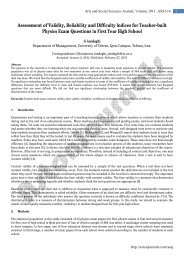
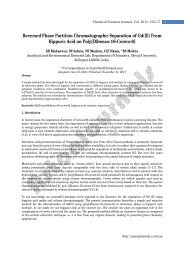
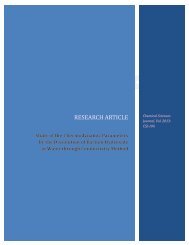
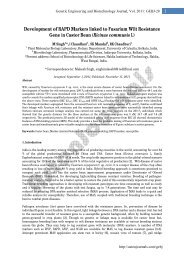

![[1,4]-benzodiazepine-2-one Derivatives as Potent - AstonJournals](https://img.yumpu.com/49117784/1/184x260/14-benzodiazepine-2-one-derivatives-as-potent-astonjournals.jpg?quality=85)
